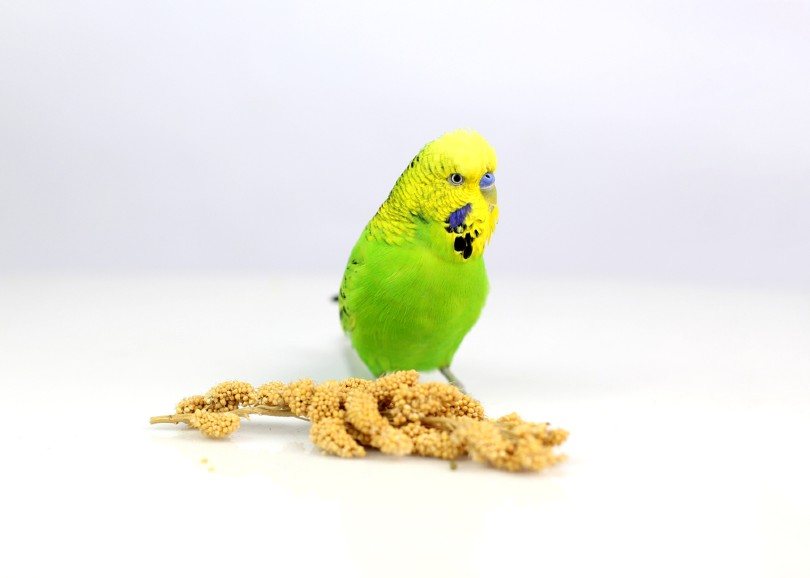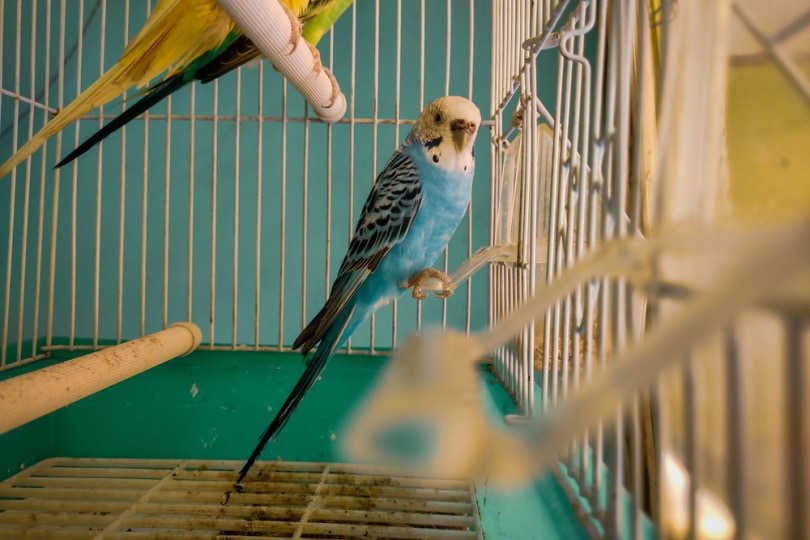
The English Budgie and the American Budgie are quite different in appearance as well as their temperament and characteristics. The American Budgie, also called the Australian Budgie, tends to be quite small in size but they can also be loud and vocal in their home.
In contrast, the English Budgie, which is also called the Show Budgie or Exhibition Budgie, is much larger but doesn’t usually vocalize as often or as loudly. The English variant can also be more laid back and more of a domesticated pet with a sweet nature, whereas it will take consistent and regular handling to discourage the American Budgie, or parakeet, from biting fingers.
It is worth noting that both breeds, even the more diminutive American Budgie, are much larger than the Wild Budgerigar.
Visual Differences

At a Glance
English Budgie Overview
The English Budgie is also called the Show Budgie or Exhibition Budgie, and its name is testament to the fact that this breed has been through generation after generation of selective breeding to create show quality examples of the bird. Although there are hundreds of acceptable colors and markings, the English Budgie tends to be larger with more defined markings, compared to the American Budgie. He also tends to be quieter, easier to handle, and can be easier to train some very basic commands. Potentially because of the selective breeding, the English Budgie has a marginally shorter lifespan than the American Budgie.

Personality / Character
The English Budgie has, over many generations, been trained to appear in shows, exhibitions, and competitions. As such, he has been bred to be quiet and laid back. He is not usually prone to biting, and even if the English Budgie is not used to being handled, he will usually gladly hop onto a person’s finger without becoming alarmed.
Similarly, the English Budgie has been trained to make as little noise as possible, and when he does chirrup, he does so quietly. He actually has just as much chance of developing as extensive a vocabulary as his American counterpart, but because he is so quiet, you may not recognize the hundreds of words he can recite.
Training
Finger training any budgie is a good idea. It enables you to more easily get the bird out of the cage when it is time to clean up or to check him over or spend some time with him. By training the budgie to readily hop onto your finger, it negates the need to try and chase him around his cage, stressing you and him out in the process.
Ideally, you should start the process as soon as possible. If you start training an English Budgie when he is less than 4 months old, you should be able to successfully finger train him and may be able to train him to talk, too.

Health & Care
The English Budgie is approximately twice the weight and size of the wild variant. He has long tail feathers and bright plumage, and he has a very distinctive appearance. A healthy budgie will care for himself, preening his feathers and ensuring that he is clean, and if your budgie is not caring for himself, it may be a sign that he is not happy. The English Budgie does have a shorter lifespan, but only by a year or so.
Suitable for:
The English Budgie is suitable for potential owners that want a sensible, quiet, and potentially loving pet bird. They are also a good choice for people that want to show their pets and their potential for being trained means that they can make excellent family pets for people of all ages.
American Budgie Overview
The American Budgie is much smaller than the English Budgie and has not undergone the same rigorous selective breeding. While he is closer to the Wild Budgie, he is still likely to be much larger. He is, however, more vocal, more prone to nipping fingers, more challenging to train, and may not be suitable for owners that are looking for a near-silent avian pet.
Personality / Character
The American Budgie is closer to his wild cousin, and this is most apparent in his temperament and character. He is usually much more vocal than the English Budgie, although this does not necessarily mean that he will have a more extensive vocabulary, just that you will be more likely to hear it. He will let his feelings be known, and he is more prone to nipping and biting your fingers.
Some owners consider the American Budgie to be a bit more challenging as a pet because he is not as laid back or accepting.
Training
Another area where the American Budgie is more obviously related to the wild budgie is in his difficult training. While the English Budgie can successfully be finger trained, sometimes with little effort, it will take a lot more time and patience to train an American Budgie in this way. Ensure that you start at as young an age as possible. Budgies are usually able to leave their parents at around 10 weeks, and if you can start training them at this young age, you will have the best chance of a well-behaved and well-adjusted family pet.
Health & Care
The American Budgie will live a little longer than the English Budgie, although this only means a life expectancy of 10 years as opposed to 8 years, so the difference isn’t huge. The American Budgie should fend for himself very well when it comes to preening and cleaning, but you should still ensure that he is doing a thorough job and doesn’t need your help.
Suitable for:
The American Budgie takes more effort to integrate into the family. You will have to spend a lot of time getting him used to being handled and need to start training from as early an age as possible. This will help stem the desire to nip at your fingers. This means that the American Budgie is suitable for owners willing to put in the time and effort, and those that are not concerned by the extra noise that this breed makes.
Can English Budgies and American Budgies Live Together?
It is usually fine for both the American and English Budgies to live together. If you do experience problems, they are likely to be caused by the wilder but smaller American Budgies starting trouble with the more laid-back and passive English Budgies. Ensure the cage is large enough and do be prepared to separate the birds if there is any sign of trouble. The American Budgie might be smaller than his English counterpart, but he can still cause injuries and do damage to the bigger bird breed.
Which Is More Likely to Talk?
The American Budgie is well known for being louder and more vocal than this English counterpart. He will vocalize his discontent, unhappiness, and pleasure, but, surprisingly, this does not mean that he is any more or less likely to talk than his more silent English cousin. Both breeds can learn how to mimic human speech, and your persistence and training regimen will have more of a bearing on the likelihood, than the type of budgie you are dealing with.
Which Breed Is Right for You?
Despite both being descendants of the wild bird, the American and English Budgie are quite different in their physical attributes and their characteristics. The English Budgie has been bred for shows and exhibitions and is happier to sit on your finger, less likely to talk, and can be as much as twice the size of the American Budgie.
The American Budgie, or parakeet, is much closer to the wild bird. He will chatter and vocalize, he is more prone to nibbling at fingers, and he benefits from a slightly longer lifespan as a result of being closer to the wild species. If you want a silent bird that integrates well and easily into family life, the English Budgie is best. Otherwise, if you want a bird that is closer to a wild bird, the American Budgie is ideal.
Featured Image Credit: Top – Arfan Afzal, Shutterstock | Bottom – Kyli Petersen, Shutterstock










